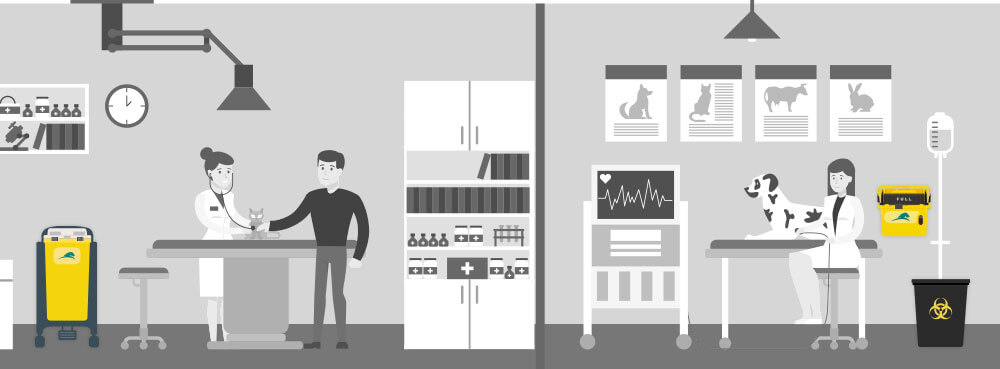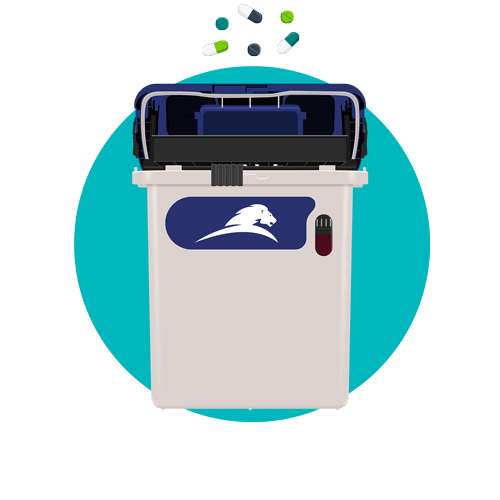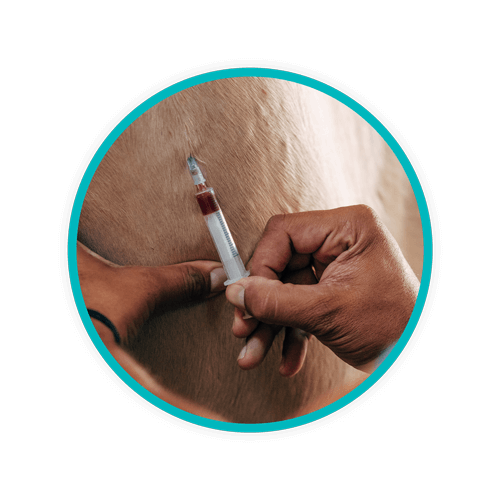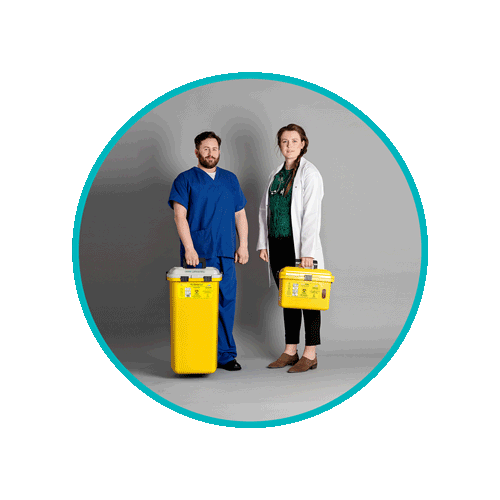Everything You Need To Know About Biomedical Waste Disposal at Veterinary Facilities

Veterinary offices are similar in many ways to human healthcare facilities in their medical waste disposal needs. Like other healthcare facilities, they produce a significant amount of non-hazardous waste that they dispose of with ordinary solid waste.
However, veterinary facilities also produce several categories of specialised wastes, including sharps, biomedical waste, and pharmaceuticals. These wastes require particular attention both in terms of storage on-site and off-site treatment and disposal. If you’re a leader at a veterinary hospital or clinic, learn what you need to know about veterinary waste and how you can set up a program for handling medical waste at a veterinary facility.
TOPICS WE WILL COVER:
1 / Setting up a medical waste program
2 / Identifying the streams of waste at a veterinary facility
Setting Up a Medical Waste Program
For new facilities, the process will begin by identifying the types of waste your facility produces, what varieties (more on that below), and how much. Daniels Health can help you remain compliant with recommendations designed to address the specific types of waste your facility generates. For the many sensitive types of waste a veterinary facility deals with, such as biohazardous materials, familiarise yourself with any local waste disposal laws regulating your options.
Identifying the Streams of Waste at a Veterinary Facility
Several potential types of waste arise in any veterinary facility, similar to human healthcare facilities, but with some unique challenges. In order to dispose of these types of waste appropriately, identifying them becomes crucial. Here are the distinct types of waste streams that veterinary facilities are likely to encounter and how to properly dispose of them.
Biomedical Waste
Employees must handle biowaste, such as faecal matter and fluids from animals and any items soiled with them, carefully. This category of waste is considered biohazardous and also includes pathological waste, which consists of any body parts, organs, or tissue.
Fortunately, this is one of the smaller sources of waste for veterinary facilities, usually less than a quarter of the total waste produced. However, these facilities must deal with this waste, so they should utilise clearly coloured and labelled containers marked with the biohazardous waste symbol to make sure employees dispose of this waste cautiously and avoid any exposure or contamination incidents.
Disposing of faeces in the general waste stream may be an option in your municipality, but often this will not be the most desirable option owing to contamination risks. As a result, it may be more desirable to dispose of faeces and other animal waste in infectious waste containers.
Though biomedical waste is not the most common type of waste that veterinary facilities will need to deal with, managing the waste properly must be a top priority. Under Canadian law, facilities remain responsible for this waste from its creation to its final treatment, making it crucial to dispose of it through a trustworthy waste management company.
Pharmaceutical Waste
As with human medications, expired or unused pharmaceuticals intended for animals pose a danger to the environment, humans, and animals if disposed of improperly. Veterinary facilities must securely dispose of these medications to prevent potential tampering and theft as well as damage to the environment and water supply.
For some medications, the pharmaceutical manufacturer may have a takeback program. However, when these options are not available and controlled, the facility must securely dispose of the pharmaceutical waste and ensure that it is transported and destroyed properly.
A solution such as Daniels’ Pharmasmart waste collection system contains built-in security features that prevent tampering and misappropriation of discarded pharmaceuticals once collected. Daniels ensures security throughout the entire process and provides certificates of destruction to give additional peace of mind and maximum security.
Deceased Animals
This is a special kind of medical waste that human healthcare facilities typically do not have to deal with on their own. Generally, when someone passes away in a hospital or doctor's office, a coroner will take the body, which a mortuary will then handle.
However, with animals, the process unfolds very differently as there are few legal requirements regulating how facilities should handle these bodies. Despite this, veterinarians will frequently face the prospect of disposing of animals that are euthanized or pass away due to injury or natural causes.
In many cases, facilities can place these bodies in infectious waste containers and dispose of them through their medical waste contractor with other hazardous wastes. However, pet owners may have a strong emotional attachment that prevents veterinary facilities from handling these bodies like other medical waste.
Many veterinary facilities form a connection with other facilities and pet cemeteries that can handle the disposal of deceased pets. As pets become a bigger part of our lives, more vet hospitals and clinics are offering individual cremation, so that the pet owners can retain cremains. For farm animals or others where an emotional attachment is not a concern, they can use more efficient methods of disposal.
Sharps
Just like human healthcare facilities, veterinarians use a significant amount of "sharps," which include any items with the potential to pierce or cut skin. Items that qualify as sharps include hypodermic needles, disposable scalpels and blades, IV ports, and glass or broken glass that could have been contaminated by hazardous substances.
These items prove to be naturally dangerous both because of their potential to cause injuries and easily expose individuals to biohazardous agents. As a result of this risk, facilities must ensure that these sharps are disposed of in a secure container that can be safely disposed of without the risk of exposure to needle stick injuries. This is where a container such as Daniels' Sharpsmart comes in. This secure, reusable container allows for effortless disposal of sharps while offering a wide array of safety features to prevent injury to healthcare providers.
When the container is full, Daniels can collect, transport, and destroy the waste in an environmentally responsible manner. Next, a robotic washing system and quality inspection ensure that each container is clean, safe, and ready to reuse in order to protect the environment from unnecessary plastic waste.
Staff Training
Understanding the different medical waste streams is one thing, but any disposal program is only as strong as the staff managing it. It is essential to equip each and every worker who has contact with medical waste with the appropriate training to identify and properly dispose of the waste generated inside your facility. Daniels can help with this process and has designed our reusable containers to be easy to recognize and user-friendly.
Conclusion
Knowing how to appropriately dispose of medical waste remains crucial for any veterinary facility in order to protect people, animals, and the environment. Veterinary facilities generate many types of waste, making it confusing to know how to handle disposal. However, Daniels medical waste management service can help guide your animal care facility in choosing the practices that will work well for your unique facility while maintaining the highest safety and environmental standards.
